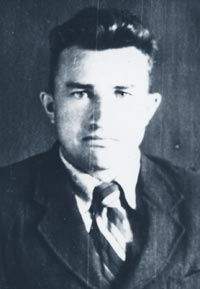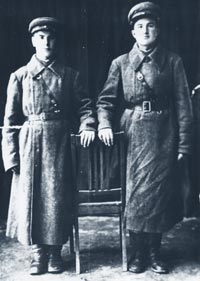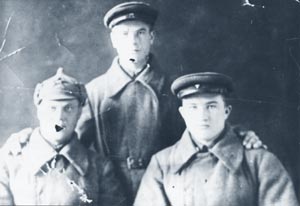









 Heinrich WOLF was born in the village of SVONARYOV KUT, AZOVSK district
(today TAURIA), OMSK region, not far from the town of Omsk, in 1920.
Heinrich WOLF was born in the village of SVONARYOV KUT, AZOVSK district
(today TAURIA), OMSK region, not far from the town of Omsk, in 1920.
It was a purely German village (resettlers from the Volga region) with four streets, each about 2 kilometers in length, and less than 300 farms.
In August or September 1937 the Communists arrested approximately 15 people from this village. They came several times during the day, in a black "Emka" (also known as "Black Maria"), and even took them right from the fields, where they were working. Heinrich cannot remember any of the family names of those who were arrested, but one of them he met again in the KRASLag - that person recognized him, when he heard his family name WOLF.
This man survived and returned to the village after his stay in the camp - the only one out of all.
 On 27.10.1940 Heinrich was called up into the army. He served in the 1st unit
of the camouflage battalion near Moscow, at the railroad stop of NAKHABINO.
On 27.10.1940 Heinrich was called up into the army. He served in the 1st unit
of the camouflage battalion near Moscow, at the railroad stop of NAKHABINO.
At the beginning of the war the battalion was moved to Moscow and stationed at the outskirts of the town, in the little spinney near the Moscow-Volga-canal. 500 men served in the battalion, among them another four Germans, all of them from the
AZOVSK district, two of them, BRAK and Hans KREIS, coming from the same village, the other two, WEIS and KAPLANOV, from other villages. They were all born in 1920 or 1921.
The battalion carried out the camouflage of many objects in Moscow and its surrounding areas (among others the Moscow Kremlin). They were caught in a bomb attack. In September the battalion proceeded to KUBINKA, in order to camouflage the airport; this meant work for a whole week or more. The airport was bombarded.
A few days later the sergeant called for all Germans, and they were taken to Moscow, where the unit had its base. For a week they stayed in the military barracks doing nothing; then the commanding officer sent for them and announced that they would be transferred to a different unit. They handed over their arms and received new uniforms. The school No. 90 in Moscow was the assembly point. There were unarmed soldiers, officers and generals. The complete mobilization took another two weeks; then the whole unit was loaded at night and taken to DZHAMBUL in KASAKHSTAN. It was said, however, that the generals (they were several) went to the Ural until the mobilization was complete and the unit departed.
They obviously left Moscow beginning of October. As far as conditions and procedures were concerned, this action gave the impression of an ordinary troop movement. They could leave the train at the railroad stops and walk on the platform. Upon their arrival in DZHAMBUL those, who had been mobilized locally, immediately joined the unit, and they were all sent to the front; however, the Germans were put up in military barracks in DZHAMBUL.
 It turned out later that they had all been sent here for the construction of
the railroad line leading from DZHAMBUL, on this side of the mountains, to the
mines. The first station after the town was PILIKUL, named after the near-by
lake, and the next one - SHALAKTAU. When the construction area moved away from
the town, they had to leave the soldiers quarters and found accomodation in
barracks and tents, which were moved from one place to the other as the
construction work progressed.
It turned out later that they had all been sent here for the construction of
the railroad line leading from DZHAMBUL, on this side of the mountains, to the
mines. The first station after the town was PILIKUL, named after the near-by
lake, and the next one - SHALAKTAU. When the construction area moved away from
the town, they had to leave the soldiers quarters and found accomodation in
barracks and tents, which were moved from one place to the other as the
construction work progressed.
In September 1942 Heinrich was woken up one night, pushed into a van and taken to DZHAMBUL. They locked him up in a prison cell at the station, where he was held in remand. He was kept there for a week, then taken to ALMA-ATA, to the inner prison of the NKVD (= National Commissioner's Office for Internal Affairs = headquarters of the national state security). There were approximately 25 prisoners in the cell. They were all accomodated on plank beds.
The interrogations took place at night, the interrogators (= examining magistrates) often changed. It is true that they were allowed to sleep during the day. After three months in the inner prison, beginning January or in February 1943, Heinrich was taken into the true hell - the TASHKENT transit camp. It consisted of barracks with 200-300 prisoners in each. The upper plank beds were continuous, made of wood, the lower ones right on the earth. During the day they were given a bowl of flour lump soup (= gruel), and only occasionally they received 300 g of bread. About ten dead bodies were carried out of the barracks every day. The transit camp had been put under quarantine, and only after two months those who had survived were taken to the AKTYUBLag, in order to carry out the construction of a metallurgical combine (possibly the copper-nickel works). When the prisoners arrived, the steppe looked still completely bare, the grass only reappeared quite gradually. Within this transport Heinrich's compatriots - KREIS, WEIS and BRAK - came to the AKTYUBLag. It turned out that they had also been arrested and imprisonned in the inner prison of ALMA-ATA.
The zone (= security zone) was surrounded by a triple barbed wire fence. The inmates ate russet-looking herrings, from which they got diarrhoea. In the beginning, the brigadier distributed two rations on three people, as long as the prisoners did not complain. The camp was subject to strict rules. Obviously, this camp only took prisoners who had been sentenced on the §58, - Heinrich neither noticed any thieves, nor "bytoviki" (insignificant everyday-crooks).
There were many Estonians, Lithuanians, Latvians and also Germans. The prisoners died in huge numbers, mainly Germans from the Caucasus.
Heinrich worked in the repair brigade, never spending any time outside the (security) zones. Then, one day, he was called to sign his sentence, "10 years Kraslag", on a scrap of paper. The same term of imprisonment was imposed on WEIS, KREIS and BRAK received a prison sentence of 8 years. They were kept in AKTYUBLag for about two months. Then they were all taken to the KRASLag.
They were on the way for a long time, passed through different transit camps. Only in October 1943 they reached KANSK, in the KRASNOYARSK region, the "capital" of the KRASLag (until 1948).
Heinrich and his compatriots first came to the security zone in KANSK, where the prisoners gathered cut timber from the river Kan, stacked it up and loaded it on wagons. In November or December 1943 a group of 200-250 prisoners hurried on foot, at severe frost, from KANSK via IRBEY to TUGACH in the district of SAYAN. There was a KRASLag camp section with a woodcutting remote camp sector, scattered in the mountains between the river KAN and its right tributary, the river KUNGUS, as well as a rural zone (= agricultural zone), and in-between the women's remote camp sector - SAMSONOVKA. A separate part of the woodcutting sector was situated on the river SHEDARBA, on the left tributary of the KUNGUS, - the NEW, OLD, LOWER and UPPER SHEDARBA.
Heinrich first stayed by the NEW, then by the UPPER SHEDARBA. With him was BRAK, who worked as a tractor driver, but was later moved to another command; nothing is known about his fate. At first, Heinrich was with the woodcutters and probably would not have survived, unless he had been transferred to a drivers' brigade - in order to transport wood to the lower timber yards. The zones consisted of approximately ten barracks for the prisoners, in each of them lived a brigade of a 40 men. Upon fulfillment of the targets they were entitled to a bread ration of 600 gr, in case they did not succeed in fulfilling the norm - 400 gr, "shock workers" received up to 1200 gr. Apart from this ration they were given - at irregular times - frozen cabbage, mangold, sometimes "balanda" - water with a handful of barley at the bottom.
Beginning 1944 Heinrich fell ill, a beginning nephritis, and was taken to SAMSONOVKA (the rural / agricultural women's commanding) , on a sledge, where they had a good surgeon, a Kasakh (Urasbaev). The operation was successful and his recovery went well; they discharged him early and brought him back to the UPPER SHEDARBA. It was end of April or beginning May 1944, and the timber season began. Heinrich asked the medical orderly to move him to a place, where he could do some light work, but instead, they brought him to the penal colony (Matveyev Klutch), not far from TUGACH, and there he stayed until 1950.
This commanding differed from the SHEDARBA one in its big number of watchmen, but the way of life was exactly the same. The barracks remained unlocked at night. Heinrich worked here in the brigade of Vassily Girin (who obviously had not been sentenced on the §58), dug up tree-strumps for the resin extraction factory. There he met on of his neighbours from the same village, who had been arrested in 1937 (see above), - within the zone he was working in the canteen. He reported that there had been times, when the inmates used to boil and eat the bridle of horses - the leather straps from horse collars.
In 1950 they started to remove all those, who had been sentenced on the §58, and there only remained the "bytoviki" and thieves. In spite of the fact that the chief tried hard to keep good workers, even if they were §58-prisoners, the remaining prisoners were sent away in autumn 1950, among them Heinrich, as well. The prisoner transport headed in the direction of the STEPLag, where the convicted men were designated for the construction of the BALKHASHK copper smelting furnace combine. This was a camp with strict rules. The barracks were locked at night-time.
On 26.05.52 Heinrich was released from the camp with papers and immediately sent to KRASNOYARSK into exile, with a one-week break in a transit camp in NOVOSIBIRSK. In KRASNOYARSK they were kept in prison for another week and then released to a special settlement, directly in KRASNOYARSK, in order to work in the 72nd construction trust, which was completely based on the forced labour of the exiled people. Maria Andreyevna Laba, who was released the same day, later married Heinrich.
The commandant's headquarters were abolished in 1956. Heinrich was rehabilitated in 1957, but only received the official confirmation in 1962, after having put forward a corresponding motion. In the middle of the 1950s I. G. KREIS, who had been released from exile and was on his way home to the Omsk region, discovered him in Krasnoyarsk. He told him that he and BRAK had been imprisoned on the LOWER SHEDARBA and released in 1950, that they had then been sent into exile to the KAZACHINSK district, where he had worked in the timber processing industry and the railroad sleeper factory. Kreis died around 1985.
Archives:
Photo archive: